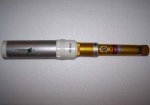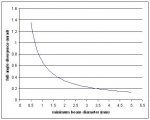I yesterday figured this out, don't know if anybody else has discovered it yet (probably someone have), but it's amazing!
The dot of my x-85 at 100m is about 15 cm wide. When i shine it through a pair of binoculars with the right zoom adjustment, the dot is about 2 cm wide at that range! that would make a divergence of about 0,3 mrad! When i usually shine it up in the night sky it's a pretty tight line, but with the binoculars, it is extremely thin!
When i usually shine it up in the night sky it's a pretty tight line, but with the binoculars, it is extremely thin!
Could someone tell me why this happens?
The dot of my x-85 at 100m is about 15 cm wide. When i shine it through a pair of binoculars with the right zoom adjustment, the dot is about 2 cm wide at that range! that would make a divergence of about 0,3 mrad!
Could someone tell me why this happens?







